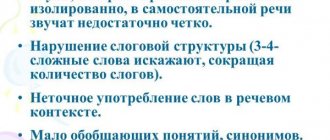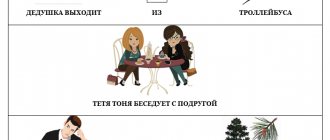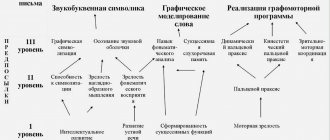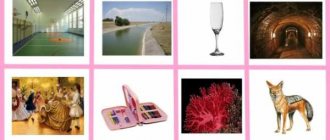Goals and objectives
The goal of the “Make a Sentence” game is to develop the lexical elements of speech and improve grammatical structure.
Tasks:
- expansion of individual vocabulary;
- learning the skill of composing simple and prepositional sentences;
- developing the ability to select homogeneous members, as well as qualities and actions for objects;
- learning the skill of expanding a sentence by adding different members;
- development of coherent speech, the ability to build a dialogue, answer and ask questions in detail and competently;
- vocabulary enrichment;
- development of imagination.
Developing a preschooler’s speech: how to help a child talk about everything in the world
Compiled by:
Chakhova Valentina Petrovna, speech therapist teacher
Russia, Tyumen, municipal autonomous institution
preschool education child development center
kindergarten No. 158 in Tyumen,
Abstract: Figurative speech, rich in synonyms, additions and descriptions, in preschool children is a very rare phenomenon. Meanwhile, mastering speech between the ages of 3 and 7 years is of key importance, because this period is the most sensitive to its acquisition. To help a child learn to speak grammatically correctly, constructing detailed sentences, it is necessary not only to talk to him often and a lot, but also to ask him to talk, ask questions and help him answer them.
Key words: speech, development, vocabulary, verbal-logical thinking, detailed story.
Children learn their native language by imitating the spoken speech of those around them. Unfortunately, busy parents nowadays often forget about this and let the process of developing their child’s speech take its course. The child spends little time in the company of adults (more and more at the computer, in front of the TV or with his toys), rarely listens to stories and fairy tales from the mouths of his mother and father, and systematic developmental activities for mastering speech are generally rare. So it turns out that by the time a child enters school, many problems arise with his speech. As they say, in order to cope with the enemy, you need to “know him by sight,” therefore, setting the task of developing the speech of your preschooler, we will consider what problems parents and teachers most often encounter in this area.
Typical speech development problems of a preschooler:
- Monosyllabic speech consisting only of simple sentences (so-called “situational” speech). Inability to construct a common sentence grammatically correctly.
- Poverty of speech. Insufficient vocabulary.
- Littering speech with slang words, using non-literary words and expressions.
- Poor dialogical speech: the inability to formulate a question competently and clearly, or to construct a short or detailed answer.
- Inability to construct a monologue: for example, a plot or descriptive story on a proposed topic, retelling the text in your own words. (But it is simply necessary to acquire this skill before school!)
- Lack of logical justification for your statements and conclusions.
- Lack of speech culture skills: inability to use intonation, regulate voice volume and speech rate, etc.
- Poor diction.
When the method of speech development was just being created in Russia, it set an even more interesting and even higher-level task - to educate a child not just in correct expressive speech, but in an individual speech style! Pushkin, Lermontov, Gogol and other writers have an individual style of speech - we will never confuse the authors with each other, feeling their author's style.
Alas, in the modern situation there is no time for this task, because... Usually children do not “mature” to this level. We are already talking about the fact that almost every child has a disorder in speech development! But a huge number of these violations simply could not have happened if the child had been properly treated and communicated in the family and in the kindergarten!
How to develop a child's speech?
Children need to learn to pronounce correctly and not skip sounds, clearly construct words and express thoughts. It is not recommended to correct and force the child to repeat words with problematic sounds if the child cannot pronounce this sound correctly or completely misses it. It is much more effective if you, by example, clearly and correctly, give your child an example of vocal communication. By the way, scientists have proven that the development of fine motor skills and the development of speech are very closely related, so we advise you to widely use games to develop fine motor skills.
If the correct speech of a preschooler has not been formed by the age of five, it is necessary to seek help from a speech therapist, a specialist at a children's clinic. It is not recommended to postpone visiting a speech therapist; the child must be prepared in terms of communication before the start of school. It is known from practice that children who cannot pronounce certain sounds correctly make the same mistakes in spelling. Before the age of six, it is possible to correct all defects.
Correct pronunciation is only part of the story. If children are deprived of preschool education in special institutions, home exercises are necessary. It is necessary to achieve a conscious understanding of words by children's perception, focusing on a refined understanding of all the nuances of their meaning.
In the development of speech in preschool children , it is important that the preschooler learns to listen, understand the meaning and respond by answering questions. Don't put your baby to sleep just by reading. For this, frequent conversations are necessary, teaching him to retell what he has read, and clearly express his thoughts and opinions. It is very good to develop memory, learn small poems and verses from songs. To develop coherent speech, you need to come up with different stories, for example based on comic books. Or get interested in a task such as composing the end of a story, stopping reading at the most exciting point. This effectively develops imagination, activity and logical thinking.
Many parents rely on kindergarten to solve the problem of speech development. It is believed that systematic classes in a group will help the child in this difficult task. Very often these hopes are not justified: in many kindergartens, insufficient attention is not paid to speech development. But even if you are lucky with the kindergarten, and native speech is given a worthy place in the classroom, it makes sense to monitor whether the baby is developing enough diction, vocabulary, the ability to use intonation, build a dialogue, and detailed answers containing justification (evidence). If not, you’ll have to think about how to diversify your preschooler’s speech practice at home.
Let's see what exercises we can do with our child ourselves. To do this, we, of course, need to know when and what stages of speech development a preschooler goes through. Therefore, we accompanied each exercise game with a detailed commentary.
Exercises for developing the speech of a preschooler:
1. Exercise “Conversation based on a picture.”
This exercise is suitable for children 3-6 years old and is aimed at developing coherent speech. Any beautiful picture, preferably with a plot, is suitable for constructing a conversation. It is most convenient to do this exercise while reading a book, putting together a puzzle or some other entertaining game, so that the child does not have the feeling of a “boring lesson”. Try to involve your child in a question-and-answer game. Ask different questions using a variety of question words: What? Where? Where? Where? How? When? For what? Why? etc. To “talk” the child, use introductory phrases (“What do you think (do you think)?”, “Have you ever seen something like this...”) or assumptions (“What if...”, “Maybe there is a I mean...", "What would you do..."). If your child finds it difficult to answer, help him construct a sentence, demonstrate how and what he can talk about. Pay attention to generalizing words and the construction of subordinate clauses, encourage the child when he uses them. This helps children learn to think abstractly without relying on specific material or situations.
The Picture Conversation exercise is aimed at developing so-called “contextual” speech. Initially, the child’s speech is directly related to the action and naming of objects. “Dad, give me”, “Mom let’s go”, “I want a doll (car, etc.)” are the first sentences that we hear from the baby’s lips. This so-called “situational” speech is a completely normal phenomenon under the age of three. However, after three, the child should begin to master abstract speech that is not directly related to the subject or situation.
If this does not happen, then our preschooler begins to suffer from pronounced tongue-tiedness and unclear speech. To construct a coherent story, a meaningful question, he needs new speech means and forms, and he can only learn them from the speech of those around him. To help a child, it is necessary not only to talk to him often and a lot, but also to ask him to talk, ask questions and answer them.
2. Exercise “Big - small”.
This exercise can be performed with a child 2.5 – 5 years old. To conduct the lesson, you can use a book with pictures or baby toys. Look at the pictures with your child and ask him to name what he sees. For example:
- Look who’s that in the picture?
- A girl and a boy.
- Which girl?
- Small.
- Yes, the girl is younger than the boy, and the boy is her older brother. The boy is tall, and the girl is shorter.
- What kind of braid does the girl have?
- Big.
- Yes, the girl’s braid is long. There is even a saying: “A long braid is a girl’s beauty.” Why do you think a long braid was considered more beautiful than a short one?
And so on.
This exercise is aimed at enriching the child’s vocabulary. After all, poor vocabulary is not only ignorance of the names of objects, phenomena and concepts. This problem concerns the entire structure of speech: the presence in it of a rich range of adjectives, verbs, adverbs, conjunctions, and participles. So, for example, if a baby uses the ubiquitous “big” instead of the adjectives “long”, “elder”, “tall”, “wide”, “thick”, “huge”, “roomy”, “great”, you should think about the use of synonyms .
3. Reading (and singing) lullabies and nursery rhymes.
Starting from birth, read traditional nursery rhymes, lullabies, jokes, and fairy tales (especially poetic ones) to your baby every day. It is very useful to read at night. When reading, make sure that the pronunciation is clear and clear, correctly emotionally charged.
Lullabies and nursery rhymes are invaluable material that allows a child to “feel” the language, feel its melody and rhythm, become imbued with tradition, and clear his language of endless slang words. Lullabies and nursery rhymes enrich children's vocabulary due to the fact that they contain a lot of information about objects and the world around them; they teach children to form words with the same root (for example, “cat”, “kitten”, “kitten”), and allow them to memorize words and forms of words and phrases , and a positive emotional coloring makes development more successful. Repeated sound combinations, phrases, and onomatopoeia develop phonemic hearing and help memorize words and expressions.
4. Interview.
This exercise is for children from 4 years old. Invite your child to do an interview like a real journalist. You will be a famous scientist or doctor, and the kid needs to prepare an article about you. You can prepare a list of questions together. Don't forget to prepare detailed answers! You will not only have a great time in the company of your child, but also instill in him social skills, and also develop the baby’s dialogical speech.
A very important technique is used in interviews: the child must ask the question correctly in order to get the answer he needs. He will have to use all his language skills to competently build a dialogue with the interviewee - that is, with you. On the other hand, the child will have to remember your answer so as not to repeat it in questions. The game can be diversified: interview on a variety of topics. This will enrich the child’s vocabulary and teach him to construct questions. You can also change roles - then the child will be able to master (following your model) the behavior of the other side and learn to competently construct detailed answers.
5. “Guess the riddle.”
The game is suitable for children from 3 to 7 years old. Guessing riddles develops children's speech in many ways. In riddles, the most striking signs of objects or phenomena are given in a condensed form. Therefore, solving riddles develops in children the ability to analyze, generalize, and the ability to identify the characteristic features of an object and draw conclusions. Some riddles enrich children's vocabulary due to the polysemy of words and help them see the secondary, figurative meanings of words. And, of course, they teach children imaginative thinking.
To arouse your child's interest in the proof, draw the child's attention to the fact that without proof you can offer a different answer. For example, the well-known riddle “The red maiden sits in a dungeon, her braid goes out onto the street.” We ask what it is. If the child has guessed the answer and shouts “carrot,” we ask why. "Because it's red." Well, strawberries are also red - does that mean this is also the correct answer?
You need to try to draw the child’s attention to the other signs indicated in the riddle. If the kid has figured it out and claims that “sitting in prison” means “growing in the ground,” then you can wonder if this is not a radish - after all, it also grows in the ground and is also red? Now pay the child’s attention to the fact that it is “she” who is sitting in the dungeon, so that masculine objects (onions, garlic, radishes) immediately disappear.
The child must learn that even little things sometimes play a very significant role in proof. Then think about what else is growing in the garden. Why couldn’t the author of the riddle mean beets, since they also seem to be red when you cut them? Let the child express his guesses. Suggest your version: beets are actually not red, but dark brown. Try to come up with your own riddles about vegetables of a different color: for example, “The yellow maiden sits in a dungeon” (turnip). Explain that the beauty of the carrot riddle is that the phrase “red maiden” has a double meaning, i.e. the author may not have in mind the color at all, but the beauty of the object.
The same leading questions can be used if the child has not guessed the answer. In this way, the baby will learn to think and express his thoughts, build reasoning.
6. “What would that mean?” Exercise for children from 5 to 7 years old.
The intonation and emotional coloring of speech have the same meaning as the words we speak, because it is by tone that we often determine the mood of the speaker and the meaning of what he is trying to convey to us. To show children the importance of this aspect of speech, it is best to use proverbs, sayings, and phraseological units of the Russian language. In phraseological units of the folk language, not only the ideas and thoughts themselves are succinctly and accurately expressed, but also their emotional connotation (condemnation, encouragement, joy, sadness, affection, anger, etc.). Tell your child a number of phraseological units or proverbs. Think with him what they could mean.
For example, what does it mean to “knuckle down”, “to hang your nose”, “to give a headache”, “as simple as a steamed turnip”. Familiarity with phraseological units improves oral speech skills, develops thinking and imagination.
7. Sayings and tongue twisters.
Pronouncing sayings and tongue twisters is useful for all children, even if the child’s diction seems fine at first glance. Preschoolers do not yet have sufficiently coordinated and clearly functioning speech apparatus. Some children do not pronounce words clearly, are in a hurry, and swallow endings; others, on the contrary, speak slowly and draw out their words unnecessarily. It must be remembered that diction is developed with the help of special classes; no one has perfect pronunciation by nature. Therefore, use the good old tongue twisters, and your baby will have fewer problems with speech.
So, about all of the above, we can conclude that speech, as a historically established form of communication, develops in preschool childhood in two interrelated directions. Firstly, its practical use is improved in the process of communication between the child and adults and peers. Secondly, speech becomes the basis for the restructuring of thought processes and turns into a tool of thinking. Mental activity is impossible without speech.
The child learns correct pronunciation and correct understanding of speech addressed to him, his vocabulary increases significantly, he masters the correct use of grammatical structures of his native language. From situational speech develops into contextual, coherent, and then explanatory. The child masters speech practically, without realizing either the patterns to which it obeys or his actions with it. And only towards the end of preschool age does he begin to realize that speech consists of individual sentences and words, and the word consists of individual sounds, he comes to the “discovery” that the word and the object designated by it are not the same thing, i.e. a word can be used as a substitute for an object even in its absence, used as a sign of an object. By mastering speech, the child also acquires knowledge about objects, signs, actions and relationships, embodied in the corresponding words. At the same time, he not only acquires knowledge, but also learns to think, since to think means to speak to oneself or out loud, and to speak means to think. The word is the material shell of thought. However, this thesis is true if behind each word the child has an image of the object that this word denotes. If a child hears adults in speech or uses words that do not have images behind them, mental activity does not occur.
After a child masters speech, the world around him seems to double. Thus, the word doubles the world and allows the child to mentally operate with objects even in their absence. This expands the boundaries of his cognitive activity: he can use indirect means of expanding his horizons (a work of art, an adult’s story, an explanation).
At the stages of early and preschool age, the most important tasks of speech development are solved: enriching the vocabulary, nurturing the sound culture of speech, forming a grammatical system, developing coherent speech. It is also necessary to develop a culture of dialogical speech: the ability to speak clearly, expressively, and to the point; listen to the interlocutor, try to understand him, do not interrupt; do not jump from subject to subject, etc. These tasks are the most important and priority in modern preschool education.
Internet resources:
https://www.rebenok.com/info/library/childrengarden/
https://rodnaya-tropinka.ru/razvitie-rechi-detej/
https://ds29.detkin-club.ru/editor/1877/files/9a4e4cde59bead50b2fe657cdd0d68cf.pdf
https://studopedia.ru/3_33601_vospitanie-lyuboznatelnosti-i-poznavatelnih-interesov.html
https://www.referatbank.ru/market/referat/rw/13630/kursovaya-gendernyie-osobennosti-rechi-doshkolnikov-.html
https://nsportal.ru/detskiy-sad/razvitie-rechi/2013/09/13/issledovatelskaya-rabota-razvitie-rechi-detey-srednego
https://doshvozrast.ru/rabrod/rodsodranie10.htm
detsad83.ucoz.ru/razvitie_rechi_u_rebjonka.ppt
Share
The first version of the game is with dice
For the game, prepare dice that are thick and of sufficient size to be able to glue pictures. Each face should have a thematic image. For example, if the topic is “Toys,” find pictures of a doll, a ball, a car, a racket, a spinning top, or a construction set. A cube with objects answers the question “What is this?” Or “Who is this?”, if the topic is family or the animal world.
It is best to cut out pictures from coloring books, because they are stylistically the same. Let the children color the images before gluing them onto the cube.
In addition to subject cubes, make the following cubes:
- depicting actions, for example, flying, walking, sleeping, crawling, running, eating;
- denoting numbers from 1 to 6 in the form of dots (or in regular Arabic script);
- color – red, blue, green, yellow, orange, purple;
- with geometric shapes - circle, square, rectangle, oval, triangle, semicircle;
- with emotions in the form of faces - happy, sad, scared, angry, surprised, angry.
There are several options for playing depending on the combinations used. The child must roll the dice. And, when the images are determined, ask him to make a proposal according to the diagram.
Examples of tasks for preschoolers:
- Object + action. We need an answer to the question “What does it do?” For example, “dad” + “read” = “dad is reading”, “horse” + “run” = “the horse is running”. Sometimes when combining options it turns out absurd, then ask your child if this can happen. If “frog” + “flies” is rolled, the player must explain that this does not happen. Ask what the frog is doing - jumping. And if “horse” + “flies” comes up, explain to the child that there are words with a figurative meaning. They say this about a horse when it runs very fast.
- Object + numeral. The answer to the question “How much?” It is important that the player pronounces the endings of nouns correctly. For example, “cat” + “seven” = “seven cats”, but “two cats”, “one cat”.
- Object + geometric shape. The player answers the question “Which one?”: “round plate”, “square table”, “oval mirror”.
- Object + color. Also the answer to the question “Which?”: “red apple”, “blue car”, “yellow mug”. We remember about the likelihood of absurdities and, as in the game “Correct the mistake in the sentence,” each time we ask the player whether such a combination is possible.
- Family + emotion. The player tells what mood the character is in based on the rolled dice: “Mom is angry,” “Son is cheerful,” “Grandfather is sad.”
Once kindergarteners can easily form two-member sentences, make the game more difficult. Let them now throw not two, but three dice. Therefore, sentences will contain 3 features:
- object + numeral + figure – “five rectangular books”;
- object + color + figure – “red round tomato”;
- object + numeral + action – “two dogs are sleeping”;
- object + color + action – “a blue car is driving”;
- family + emotion + action – “surprised grandmother sitting”;
- object + object + action - “mother and girl are reading.”
Games to familiarize yourself with the verbal composition of a sentence.
a) “Raise the number” Purpose: to teach how to determine the number of words in a sentence by ear. Material: signs: sets of numbers (for each child)
Progress of the game. The presenter says the sentence out loud, and the children count the number of words and raise the corresponding number. Initially, sentences without prepositions and conjunctions are used for analysis. Suggestions for the game: 1. Alyosha is sleeping. 2. Petya feeds the chickens. 3. The doctor is treating a sick child. 4. Mom bought Natasha a beautiful doll. 5. A strong athlete easily lifted a heavy barbell.
b) “Think and say” Goal: developing the ability to compose a sentence with a given word, determine the number of words in a sentence and name them in order
Progress of the game: The teacher invites the children to make up a sentence with a word, for example, TOY (any other word). He interviews 5-6 children, and each of them, having made a sentence, names the number of words in it and the words in order, and draws a diagram.
3) Games to familiarize yourself with the word
a) “Which word is lost?” Goal: developing the skill of independently naming different words.
Progress of the game: The teacher invites the children to suggest words that are lost: “The mistress abandoned the bunny - she was left in the rain ... (bunny). Our Tanya loudly... (cries), dropped into the river... (ball). Hush, Tanechka, don’t... (cry)! It won’t drown in the river... (ball). They dropped the bear on the floor and tore off the bear's... (paw). Anyway, I won’t ... (give him up) because he ... (good). The goldfinch sings all day long in a cage on the window. He has entered his third year, but he is afraid of... (cats). That’s how many words you suggested to me, all the words have now been found, and I will read you the poems of Agnia Lvovna Barto with all the words.”
b) “Name tasty words” Goal: expanding your understanding of words.
Material: chips - prizes, basket.
Progress of the game: children fill a basket of “tasty things”, putting chips into it, which the teacher gives for each correctly named word.
Games to familiarize yourself with the syllabic structure of words
a) “Receive a telegram”
Goal: mastering the action of syllabic division of words.
Material: prize chips, object pictures, the names of which consist of one-, two-, three-syllable words.
Progress of the game: the teacher gives the children object pictures and asks them to determine the number of syllables in the words - the names of the pictures. Children determine the number of syllables and, based on their number, lay out chips, that is, “send a telegram.” The driver checks that the task is completed correctly.
b) “Solve the puzzle”
Goal: teaching children to isolate the first syllable from a word, to compose words from syllables.
Material: Cards with images: Pigeons, crayfish - mountain Bottle, rowan - borax Balls, basins - mint Ship, lark - leather Rusks, balls - land Chamomile, basins - company Telephone, raspberry - theme Stocking, houses - miracle Carriage, rowan - Varya Pencil, jar - boar Banana, butterfly - Baba Kolobok, stamp - mosquito Girl, shovel - Chanterelle's business, plane - fox Fur coat, rocket - Shura
Progress of the game. Children are given cards with two pictures on them. There is a word “hidden” on the card. It must be compiled by isolating the first syllables from each word - name, and then forming a word from them, for example: chamomile, airplane - dew. The one who composes the most words wins.
Where to start classes
The mechanism of speech formation in a child starts from the very first day of life. In order for this process to proceed quickly and smoothly, we, adults, need to become its most active participants. This long-term investment of our strength and emotions will pay off in spades in three to four years, when we get an interesting interlocutor with his own unconventional thinking and judgments. Speech development in children is the daily work of the baby and parents. Let's look at the stages of speech development in a child.
Where to start? Parents are a speech model for the child. That's why it's so important to be careful not only about what you say, but also how you say it. From the very first days, stimulate the baby’s speech: talk to the child as much as possible - pronounce the words clearly, slowly, but emotionally. Voice everything you do, but try not to limit yourself to everyday speech. Read nursery rhymes, poems - everything that is rhythmic and good for the ear. Look together, or rather, study the pictures in the book your child loves, ask questions. At first he will only show what you ask, and then try to repeat after you. Play toys and theater with your child. Give him an example of how to structure dialogues and situations, and gradually the child will answer you, and then he will come up with the conditions of the game himself.
Speech is life itself, so don’t limit your learning to printed materials and interactive toys. The surrounding world and nature will inspire your baby to new verbal discoveries, develop imagination and awaken the imagination. While walking, try to pay attention to such details as a curled dry leaf that looks like a tube, which can become a spyglass, or a drop of dew, which could very well become a real sea for ants. In the summer, build sand castles with winding passages, fly paper airplanes together, and lay out drawings from natural materials in the sand. In the fall, collect bouquets of leaves (at the same time learn the names of trees, shades of flowers), acorns, maple seeds, which will then be used for crafts. In winter, make snowmen and paint them with paints, bring home an icicle and let it melt in a basin. In the spring, launch boats in streams, show your child some drops, listen to the chirping of sparrows. All these actions fit into the child’s routine moments and do not require special costs. But if you miss time and leave the baby to his own devices, then closer to school you will have to make up for lost time by leaps and bounds, and what was so naturally laid down in childhood will have to be crammed in in large portions. And from such information overeating, you know what happens: fatigue, nervousness, reluctance to learn.
Unfortunately, not every parent has the time and opportunity to work systematically with their child. Specialist teachers can come to the rescue, including children's speech therapists in children's development centers. Most often, their programs are aimed at ensuring that the child develops harmoniously, receiving and assimilating information in accordance with age and individual characteristics.






